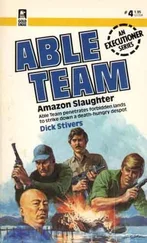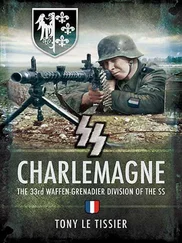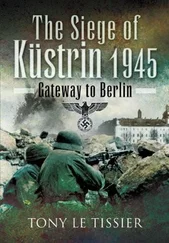• Part of the Potsdam garrison;
• Five officers and 65 men of the 243rd SPG Brigade;
• Part of HQ Battery, 1170th SPG Brigade;
• The last ten officers and men of 541st Volksgrenadier Division;
• Female Flak and Signals auxiliaries;
• Probably also some members of XXXXVIII Panzer Corps. [7] Ibid ., pp. 121–2.
The inclusion of the female auxiliaries is astonishing in view of the record of Soviet troops, but one must presume that this was not known to the Americans, or they would not have done this.
The prisoners who remained in American captivity had a rough time. The discovery of the Nazi concentration camps so enraged the Americans that they obliged their prisoners to remain in open fields, resulting in a high death rate. Those who were handed over to the French and Belgian authorities to assist with the post-war recovery also had a hard time, being obliged to work and live under severe conditions. The lucky ones were handed over to the British, who tended to allow the German units to administer themselves until such time as they were able to release individuals by their civilian categories to meet the demands of restoring the German economy.
On 2 May 1st Ukrainian Front reported to Moscow:
1. On 1 May 1945 the front’s troops finally concluded the destruction of those encircled elements of the enemy’s 9th Army in the area east, north and north-west of Luckenwalde.
On 30 April 1945 the encircled elements of the enemy’s 9th Army, with a combined strength of up to 25,000 men, were at first split into three groups and then completely destroyed or captured during the course of the day. Individual enemy soldiers were captured in the woods. During the course of the day 18,500 prisoners were brought in, mainly from the encircled groups.
2. The main forces of 3rd Guards Army, together with elements of 28th Army, destroyed the enemy east of Luckenwalde during the course of the day…
During the day the army brought in up to 9,000 prisoners and captured 58 tanks, 100 guns and 600 vehicles.
4th Guards Tank Army
10th Guards Tank Corps and 5th Guards Mechanized Corps conducted fighting with part of their forces and eliminated the encircled enemy south-east of Beelitz and north of Luckenwalde. During the course of the day they brought in up to 4,000 prisoners.
13th Army, with four rifle divisions, fought to liquidate the encircled enemy north-east and north of Luckenwalde, as a result of which the enemy was destroyed. During the course of the day up to 4,500 prisoners were brought in. [8] Lakowski/Stich, Der Kessel von Halbe 1945, pp. 133–5.
According to Soviet accounts – there are no German ones available – 60,000 dead were left behind in the fighting south-east of Berlin, and 120,000 took the difficult path into captivity, including seven generals. All the army’s equipment was lost.
There are no details available on Red Army losses in the fighting for the reduction of the Halbe pocket, but during operations from 16 April to 8 May, 1st Ukrainian Front lost 113,825 men killed, wounded and missing; 1st Byelorussian Front lost 179,490 in the same period. [9] GPW, p. 385; Lakowski/Stich, Der Kessel von Halbe 1945, p. 138.
Immediately after the fighting ended the Soviet writer Konstantin Simonov was on his way to Berlin by jeep. As he drove along the autobahn past the Halbe break-out point near Teupitz he came upon an unforgettable sight:
Shortly before reaching the great Berlin Ring, I came across a sight that I will certainly never forget. In this area the autobahn is enclosed on both sides by thick woods that had been split by a cutting whose ends were out of sight.
The German troops that were still holding out on the Oder, when the fighting in Berlin had already started, had used this route to try and thrust their way across the autobahn. Before dawn, only a few hours previously, the intersection of the cutting and autobahn that we had reached had apparently become the site of their final defeat. In front of us lay Berlin, on our right the cutting completely blocked with quite improbable scenes – a pile of tanks, cars, armoured cars, trucks, specialized vehicles, ambulances, all literally piled up on top of each other, tipped over, sticking up in the air. Apparently while trying to turn round and escape, these vehicles had knocked down hundreds of trees.
And amid this chaos of iron, wood, weapons, baggage, papers, lay burnt and blackened objects that I couldn’t identify, a mass of mutilated bodies. And this carnage extended all along the cutting as far as I could see. All around in the woods there were dead, dead and yet more dead, the corpses of those who fell while running around under fire. Dead and, as I then saw, some alive among them. There were wounded lying under blankets and greatcoats, sitting leaning against trees, some bandaged, others bleeding and not yet bandaged. Some of the wounded, as I only later noticed, were lying along the side of the autobahn. Then I saw some figures moving among the wounded, apparently doctors or medical orderlies. That was all on the right-hand side.
The autobahn ran down the centre, a broad asphalted road that had already been cleared for traffic. Along a stretch of 200 metres it was pocked with small and large craters that the military vehicles driving to Berlin were having to zigzag round.
The cutting continued on the left-hand side, and part of the German column that had already crossed the autobahn was destroyed here. Again, as far as the eye could see, there was a mess of burnt-out, smashed, overturned vehicles. Again dead and wounded. As an officer hastily informed me, the whole of this vast column had come under fire from several regiments of heavy artillery and a few regiments of Katyushas that had previously been concentrated in the vicinity and had fired on the cutting on the assumption that the Germans would try to break through here.
We left this scene of horror and after a few kilometres saw a convoy of five or six ambulances coming towards us. Apparently someone had summoned reinforcements from our medical battalions but, considering the scale of the slaughter, these five or six vehicles would be no more than a drop in the ocean. [1] Simonov, Kriegstagebücher , p. 105 f.
This was the situation that faced the victors in May 1945. Apart from evacuating prisoners and tending to the vast numbers of wounded, the dead had to be buried as soon as possible, a gruesome task that was passed on to the local population, consequently mainly to women and teenagers, to which were added teams of former Nazi officials and prisoners of war.
Elisabeth Schulz gave her account regarding the fate of the wounded:
I was then nineteen years old and working as an auxiliary nurse in Schloss Baruth. At about 0900 hours on 20 April 1945 we were told that it was everyone for themselves. The wounded could not be taken along with us. We were three nurses, two medical orderlies and two Hiwis [Russian volunteers]. We decided to stay until all the wounded were gone. Some left on wagons with the nurses and doctors.
With part of the Schloss already on fire, we put the last eighteen severely wounded on a haycart. They were only wearing shirts, as the quartermasters had shut up shop and made off. What the poor boys had to suffer was indescribable, but there were no complaints. They were grateful for being saved, as they thought. The Hiwis had found two horses and we set off across the Schloss park. By the time we reached the meadows, the Russian tanks had already passed us, and there was firing from all sides. We quickly laid the wounded down on the grass and took cover. Everything then happened very quickly. We watched the Russians charge across the meadows and shoot medical orderlies, nurses and wounded. I have to thank my fellow nurse, Hedwig Steicke, for saving my life. She ran back with me across the park.
Читать дальше












